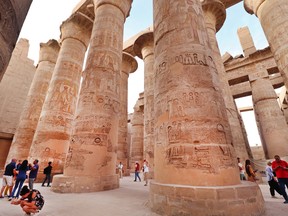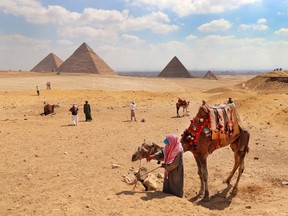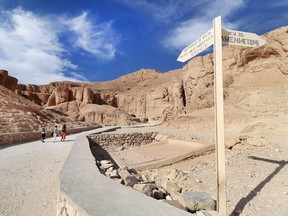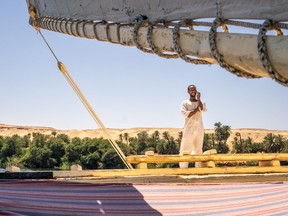Reviews and recommendations are unbiased and products are independently selected. Postmedia may earn an affiliate commission from purchases made through links on this page.
Travel
Travel Blog: Sailing through the Egyptian desert

The Nile is an oasis in a country covered by desert and a peaceful retreat from the chaos of Egyptian roads
Article content
The Nubian flag flaps in the wind funnelling up the River Nile. Sitting near the flag of his ancient roots, Faird leans heavily into a thick wooden rudder, turning the 14-metre felucca to the left.
Advertisement 2
Article content
“It’s really heavy. Do you want to try?” he asks timidly.
I politely decline, noting I’d likely end up in the Nile if I’m in charge of steering the traditional Egyptian sailboat slowly zigzagging down the longest river in the world. The open-deck boat blanketed with colourful cushions is my home for the next 24 hours, along with nine other people exploring ancient Egypt with Intrepid Travel.
Boarding the felucca in the southern city of Aswan, I’m treated with a snapshot of daily life along the Nile. Lanky palm trees line the riverbank that’s sprinkled with small crops, livestock and mud-brick homes in Nubian villages. A golden sea of sand looms in the distance.
The Nile is an oasis in a country covered by desert and a peaceful retreat from the chaos of Egyptian roads.
Article content
Advertisement 3
Article content
“The River Nile is the source of life,” says my Intrepid Travel guide Ahmed Mostafa, noting 95 per cent of Egypt’s population lives along the Nile. “We call the river the backbone of Egypt and it’s a gift from the gods. The Egyptians still worship it.”

Like most people, I came to Egypt to experience ancient tombs built for pharaohs and elaborate temples created for worshipping gods. The adventure begins in Cairo, where I’m surprised to find streets jammed with cars and people at 2 a.m. due to Ramadan. The air is delightfully warm, the energy pulsing in a sprawling city packed with 22 million people.
Wandering around the massive Pyramids of Giza the next day is surreal. The largest pyramid rises nearly 500 feet and has stood tall for some 4,500 years. How humans could build such a colossal structure back then is baffling. But I soon realize Egypt has much more to offer than just the famous pyramids.
Advertisement 4
Article content
After watching the sunrise on the Nile, our group bids farewell to Faird and the rest of the felucca crew, then head for the small city of Luxor, which was the capital of ancient Egypt for more than 1,000 years. On the way to Luxor, I see farmers working small crops by hand and people whizzing around on carts pulled by donkeys.
Being here feels like stepping back in time. Being in Luxor feels like stepping into another world.

Home to 5,000 tombs and over 40 per cent of Egypt’s temples, including Karnak (believed to be the largest religious site in the world), Luxor is an open air museum that has ruins scattered across the west bank.
Buried under the shadow of a pyramid-shaped peak looming over an isolated valley are 64 tombs, 26 of which belong to the most famous kings and some queens. This is the Valley of the Kings. Some tombs are 3,500 years old. The deepest is 210 metres.
Advertisement 5
Article content
The most famous tomb belongs to King Tutankhamun, who took the throne at nine years old and died around 1200 BC at the age of 19. His tomb wasn’t discovered until 1922 and is the only royal Egyptian tomb found almost entirely intact (with treasures) in modern times.
“Ancient Egyptians believed second life after death was a better life and only good people go there, so they prepared very well for this journey and buried with them in the tomb everything they may need,” says Ahmed. “When you look around the mountain, you see how they cut in the tombs and covered it all to be hidden from people. It is a perfect tomb for a perfect life.”

Walking into some of the lengthy tombs, I’m astounded by the walls coated with colourful hieroglyphs — the formal writing system used by ancient Egyptians for nearly 4,000 years. Elaborate scenes depicting the journey to the second life are further down inside the tomb. I try to make sense of what I’m seeing. Soaking in all the details is overwhelming.
Advertisement 6
Article content
These ancient wonders are magical, but being a tourist in Egypt isn’t easy. I’m continually harassed by persistent vendors or people wanting money for services I don’t ask for. There’s also a heavy police presence in cities, along with several police checkpoints on highways in between, ensuring citizens and tourists are safe from potential terrorist attacks that have rocked parts of country in the past.
Among the uncomfortable moments are also memorable ones like feasting on delicious, cheap local food, and strolling along the corniche in Luxor where I catch the attention of several young girls. Delighted to see a blond woman in a predominantly Muslim world, they smile at me and giggle, then ask to take a photo. I feel like a celebrity.

IF YOU GO:
Intrepid’s 15-day Explore Egypt tour consists of sailing on the Nile in a traditional felucca, spending a night in a Nubian home, exploring the cities of Luxor, Aswan, Alexandria and Cairo, and a day of snorkelling in the Red Sea. For more information visit Intrepid Travel.
Recommended from Editorial
Article content




)






